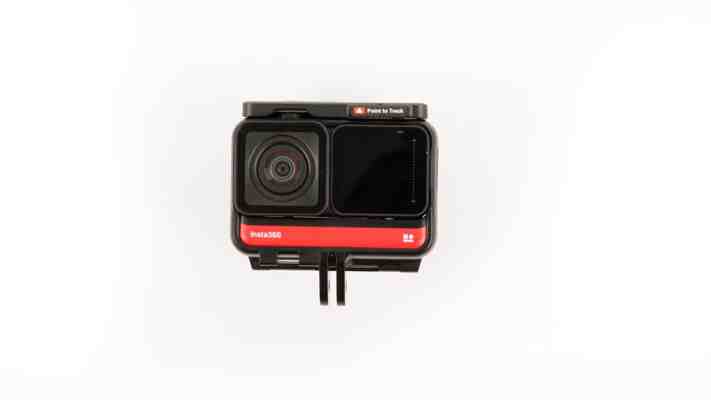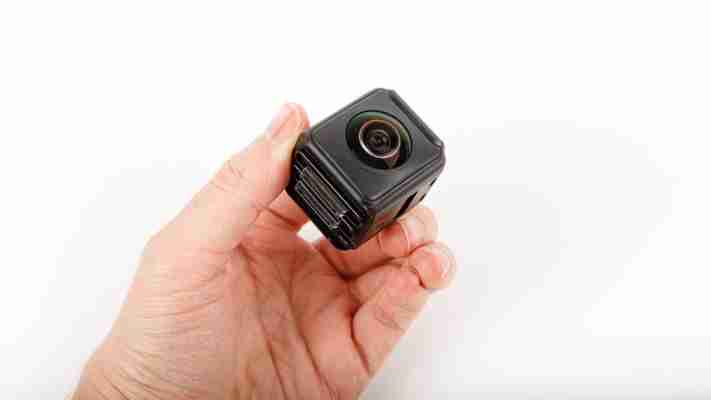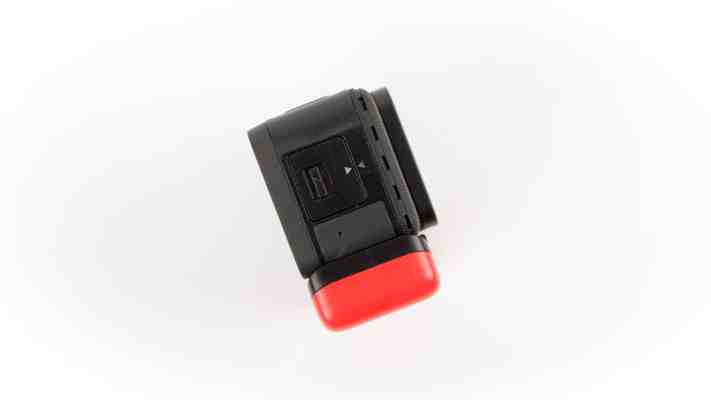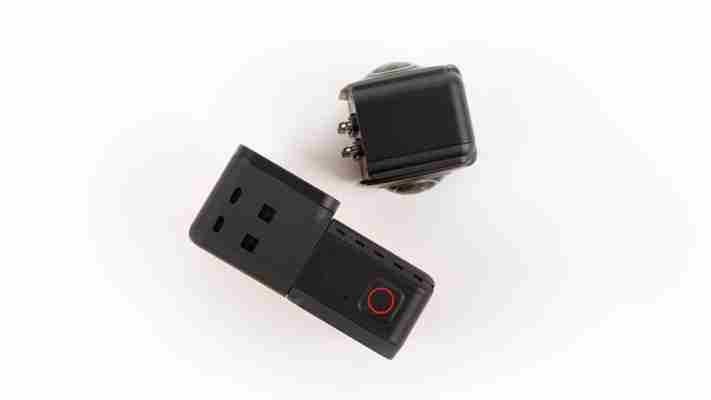Insta360 One R review: Lights, camera – action, action, action
by Miles Warren
April 19,2022
If you’re in the market for an action camera, you’ve never been more spoilt for choice. Whether you’re looking for high frame rates, silky smooth stabilisation, intuitive apps, or even 360-degree video capture, you’ll find something that ticks the right boxes. But what if you’ve only got the space in your bag or your budget for one? The modular Insta360 One R might be the answer.
It may look like a regular GoPro clone but the One R is actually many cameras in one, comprising three distinct modules: the core, camera, and battery. You have the ability to mix and match these modules depending on what your current shooting situation calls for.
READ NEXT: GoPro Max review - the best 360-camera you can buy?
Insta360 One R review: What you need to know
It’s best to think of the Insta360 One R as many cameras in one device. In the case of our review model, it came in the form of two cameras in one: a 4K action camera like the GoPro Hero 8 Black and a 360 camera like the GoPro Max.
Why would you want two (or more, potentially) different types of action cameras? The reason is image quality. Although you can use a 360-degree camera like the GoPro Max or the Insta360 One R’s 360 to replicate what you get from a single-lens action camera, currently such cameras can’t output at 4K.
Effectively, the One R gives you the best of both worlds: 4K resolution at 60fps when you want the best quality possible and 360-shooting when you’re after more flexibility – the ability to shoot multiple angles simultaneously without having to worry about where the camera is pointing.
There’s even a Leica-branded mod available for the One R system that comes with a larger, 1in sensor, for the those obsessed with getting the ultimate in image quality. Note, we weren’t supplied with this mod but will be updating this review in due course when it eventually arrives.
Buy now from Insta360.com
Insta360 One R review: Price and competition
The Insta360 One R is as keenly priced as it is innovative. Indeed, for the twin pack, I was sent for this review, Insta360 is charging £440, which is less than the GoPro Max costs on its own ( £465 ). Add the GoPro Hero 8 Black to that at £349 and you’re looking at a total of £814. Nearly double, in other words.
And you don’t have to commit to buying two lens modules with the One R, either. Choose just the 4K module and it’ll cost £300; you can always add the 360 mod later at a cost of £180. The 1in Leica module is a tad more pricey at £280 on its own or £520 as part of a single module kit.
It’s also great value for money compared with other cameras in the Insta360 range. The Insta360 One X, which is a 360 camera capable of capturing 5.7K 360 footage at 30fps and outputting reframed regular video at 1080p/30fps (the same as the 360 mod on the One R), costs £410. Again that’s only £30 cheaper than the twin-camera One R system.
Insta360 One R review: Design and key features
It’s clearly fantastic value for money but does it stack up when it comes to features, design and image quality? On the first two counts, yes it does.
The camera is made up of three components. The core module houses the brains of the operation, a 1.3in colour touchscreen, the device’s power and shutter button, plus a USB Type-C port and microSD card slot covered by a latched flap.
Camera modules can be attached to this either forwards or backwards, giving you the option to use the display normally or as a selfie screen for vlogging and the battery clips to the bottom of these two modules, holding everything together.

Initially, there are three camera modules to choose from: a 4K, f/2.8, 16.4mm wide-angle camera; a 5.7K, f/2 dual-lens 360-degree camera; and, lastly, a 5K, f/3.2, 14.4mm wide-angle camera produced in partnership with Leica, housing a larger 1in sensor.
Attach the 4K camera module and you have a traditional action cam, just like a standard GoPro. This module can shoot 4K video at 30fps or 60fps and at up to 200fps in Full HD or 100fps in 2.7K.
The 360 module mirrors most of the specifications found on Insta360’s flagship 360 cam – the Insta360 One X – and goes toe-to-toe with the GoPro Max. This allows you to record 360-footage at up to 5.7k at 30fps, and you can choose to crop and reframe the footage after you’ve captured it and export it as a 1080p 30fps video.

The 1in module brings something unique to the table as it makes the One R the first waterproof action camera to feature a sensor of this size. The 1in sensor records video at up to 5.3k at 30fps and the larger sensor size should provide it with higher quality results than the regular 4K module while filming in bad light, although note that this module does have a slightly smaller aperture of f/3.2 versus the 4K module’s f/2.8 meaning that some of that advantage will be lost.
The camera also utilises Insta360’s “FlowState” electronic stabilisation tech, which is similar in function and effectiveness to GoPro’s HyperSmooth stabilisation, smoothing out video footage with almost gimbal-like smoothness.
The camera setup is rounded out with a pair of battery module options (external charging is also supported via the Core module’s USB Type-C port). The larger of the battery options has pop-out mounting legs like on GoPro’s Hero 8 and Max. The smaller, 1,190mAh battery allows for the R to fit into a traditional mounting cage. These mounting options mean you should be able to use the One R with any of the GoPro-compatible attachments and harnesses that are currently available.

The camera is lightweight but everything feels solidly built. You connect the different modules by lining up matching sets of pins and interconnecting tabs, then everything clicks together rather satisfyingly. With the smaller battery pack attached it feels a little shorter than your standard GoPro camera but any size advantage is lost once you fit it into the cage or attach the larger battery.
Impressively, and despite the modular design, once everything is assembled the One R is rated as being IPX8 water-resistant, meaning you can submerge it in water up to 10m deep without the need to put it in a case. For anything deeper, you’ll have to clip it into a dive case, though, and it’s also worth noting that the One R is inferior in this respect to the GoPro Hero 8 and 7 Black. Both of these are water-resistant to 10m without a case.
For audio, the One R includes three microphones but for those looking to up the quality of their recordings the USB port also supports USB Type-C to 3.5mm jack adapters for external microphone options. If wires aren’t really your thing, Insta360 told us you can also pair the One R with a microphone-equipped Bluetooth headset.

Insta360 One R review: Ease of use and software
To make it to the top of the action cam heap, brands need to take ease of use and the software offering as seriously as their hardware, doubly so for 360 cameras, and especially if you have two different types of camera to deal with. I’m not going to cover every feature here, then, but will pull out some highlights and problems.
First up, using the camera via the tiny 1.3in touchscreen on the rear of the One R is a bit of a chore. Insta360 has done its best here, to be fair, and most features are accessible via a few swipes and taps but it’s the size of the display that gets in the way most here. That and a couple of infuriating design and usability decisions. The camera doesn’t, for instance, start recording the moment you press the record button. You have to back out of the menu you’re in first.
That’s perhaps something Insta360 will fix in a forthcoming firmware update but this, coupled with the slowness of the camera to start recording, even once powered up means it can be a frustrating camera to use. It takes a good couple of seconds to start recording after you’ve pressed record.
The Insta360 One R’s app, on the other hand, is impressively usable. It takes some getting to grips with but, for my money, it rivals and even bests GoPro’s app in some regards. I found it connected to my iPhone 11 Pro Max reliably and swiftly and it’s great that you can edit video clips in place on the camera so you don’t have to download the whole clip to your phone. Insta360 does recommend you connect the camera to a power bank while doing this, however, as it does drain the camera’s battery rather quickly.
In 360 editing, I particularly like the way the footage always stays level in the edit window and is locked to whatever field of view you have selected in the app. That makes it much less fiddly to edit with and reframe 360 footage than with the GoPro Max’s app, which I’ve found I need to constantly tweak to keep on the level.
There are other features specific to the 360 workflow that I like, too, particularly the multiview feature, which lets you quickly assemble two points of view from the same 360 clip (split-screen and picture-in-picture options are available) allowing you to keep yourself in frame, for instance, and something else you might want to show.
And there’s also subject tracking, which can initiate either in the app while editing – simply hold your finger on the subject you want to be tracked and a box will appear surrounding that subject – or by pointing the camera at what you want to track and saying “track that”.
The One R also provides in-camera stitching for all of your 360 footage, so you don’t have to mess about combining the footage yourself in the edit and it generates full 360 previews and playback on the camera in a first for a 360-degree action camera.
Of course, there are other bells and whistles here as well, including – inevitably – a sprinkling of AI. This helps the camera to identify people, pets, objects and scenes in your footage and provides suggestions for quick edits, automatic time-shifts, colour correction and tracking for 360 clips.
Alas, I found the AI suggestions weren’t all that helpful and the analysis was on the slow side, too. Still, the manual editing functions are pretty effective and make it easy to put together a single clip or multi-clip edit without too much faffing about.
Insta360 One R review: Image quality
So far, the One R has proved to be very much a mixed bag of positives and negatives and that very much continues on to image quality. On the one hand, I very much liked the image quality delivered by the 360 mod, which can capture 5.7k spherical video at up to 30fps, 4k spherical video at 60fps and 3K slow-motion footage recorded at up to 120fps.
Let’s start with the camera’s FlowState stabilisation. This works well, keeping shots steady, even in fairly demanding situations. I took the camera out for a run at sunset and despite the half-light the footage was usable and smooth. Impressively, even when turning the camera upside down, the horizon stayed upright.
One note: you can’t use HDR and stabilisation in tandem without experiencing weird motion artifacts. This is because the HDR mode, Insta360 tells me, is only intended for static shots, not action shots. If so, one wonders why the two settings are allowed to be enabled at the same time in the first place.
Still, footage quality is otherwise very good. I prefer the GoPro Max’s colour rendering – even with the One R’s Color Plus mode enabled it just doesn’t seem as naturally punchy – but that’s not to say the One R is bad. In fact, you may prefer the way it renders colours and you can always opt to shoot in Log and colour grade the footage yourself later if you want a different look.
I also found that, in auto mode, the One R’s exposure settings tended to lift the shadows more than the GoPro Max, resulting in more shadow detail but slightly paler skies. This is less of an issue and, if it isn’t to your liking, you can always notch down the exposure compensation – this can be adjusted in half-stop increments.
The final small flaw is that the in-camera stitching isn’t as good as it is on the GoPro Max for close up features. Used judiciously, this won’t be much of an issue in day to day shooting because scenery further than a metre or so away is stitched smoothly, but the difference is there for closer stuff and it’s noticeable. Overall, though, the results are pleasing from the 360 mod and pretty amazing for a camera this cheap.
As for the 4K mod, that’s an entirely different story. With this lens attached, you can shoot fully stabilised footage at up to 4K 60fps, and there are a number of other modes, including slow motion, timelapse and video-based, stabilised “TimeShift” modes to play around with as well. The latter works quite nicely for action work and is comparable to GoPro’s Time Warp mode.
However, my experience with regular video capture at 4K has, so far, been patchy in the extreme. I’ve primarily had issues with overly noisy footage, much more so than with the 360 module. Insta360 recommended turning off Auto action mode to improve this and it worked up to a point but it still wasn’t ideal. I also saw distracting shimmering artifacts to the stabilisation in my 4K shots which I didn’t see with the 360 footage.
Most of these issues can be improved upon by dropping down to 1080p. This sorts out the stabilisation problems and eradicates much of the noise but if you’re going to do that, you might as well just stick with the 360 module. Added to all this, I’m not overly keen on the wind noise suppression on the camera, which turns audio into a swirly, squelchy mess.
Buy now from Insta360.com
Insta360 One R review: Verdict
It is possible that Insta360 will issue a firmware update to fix all of these problems with the 4K module. I was initially supplied with the camera in pre-release form and, when it arrived, I had to wait over a week for the app and firmware to be supplied so the camera would actually function. It is clearly in need of another round or two of updates and, if these improve the overall image quality, I’ll certainly revisit the review and the conclusions that follow. I was emailed about one such update as I was preparing this review for publication.
However, given that the Insta360 One R is available for preorder, my advice for now is to hold off buying one of these cameras.
On paper, it’s a great value proposition and, in the flesh, the modular system really does work. It’s reasonably water-resistant, compact and well made and, though the camera menus are fiddly, the app is excellent in many regards. The 360 part of the system produces cracking 360 and reframed footage that isn’t a million miles behind dedicated 360 cameras like the GoPro Max. All good.
But – and it’s a big but – the other half of the system just isn’t up to scratch. It’s nowhere near the quality of a standard GoPro or a DJI Osmo Action , despite impressive specifications. Footage is overly noisy, and the stabilisation doesn’t work very well at all.
If the company can fix the quality issues with the 4K module via a firmware update and the 1in module turns out to be a zinger, then all is forgiven. For now, though, the Insta360 falls frustratingly short – a great idea that’s three-quarters of the way to being a brilliant product.
